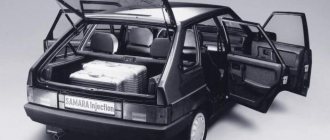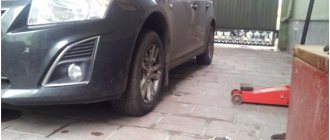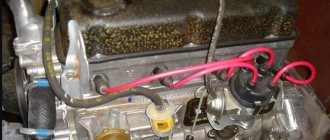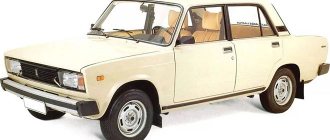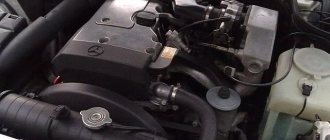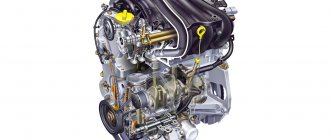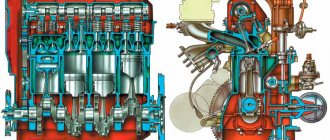Characteristics of the VAZ 2101 engine
Years of production – (1970 – 1983) Cylinder block material – cast iron Power system – carburetor Type – in-line Number of cylinders – 4 Valves per cylinder – 2 Piston stroke – 66 mm Cylinder diameter – 76 mm Compression ratio – 8.5 Engine displacement VAZ 2101 – 1198 cm cube Engine power VAZ 2101 – 59 hp. /5600 rpm Torque - 89 Nm Fuel - AI92 Fuel consumption - city 9.4 l. | track 6.9l. | mixed 9.2 l/100 km Weight of the VAZ 2101 engine - 114 kg Overall dimensions of the VAZ 2101 engine (LxWxH), mm - 540x522x621 What kind of oil to pour into the VAZ 2101 engine: 5W-30 5W-40 10W-40 15W-40 How much oil is in the 2101 engine: 3.75 l. When replacing, fill in about 3.5 liters. Service life of VAZ 2101: 1. According to the plant – 125 thousand km 2. In practice – 200 thousand km
TUNING Potential – 200 hp. Without loss of resource, about 70-75 hp.
Engine 2101 was installed on: VAZ 2101 VAZ 2102 VAZ 21035 VAZ 21041 VAZ 21051
What engines were the first VAZs equipped with?
“Kopeykas” were equipped with two types of power units: 2101 and 21011. The design of the first was borrowed from the Italian Fiat-124. But this was not a copy, but a real improved version, although the camshaft was modernized. Unlike the Fiat, in which it was located at the bottom of the cylinder head, in the VAZ 2101 the shaft was located at the top. The working volume of this engine was 1.2 liters. It was capable of developing a power of 64 hp. s., which was plenty at that time.
The design of the “penny” engine was borrowed from Fiat
The VAZ 2101 engine differed from its predecessor in volume, which increased to 1.3 liters, and, accordingly, in the size of the cylinders. This did not lead to a significant improvement in power characteristics, however, it was this unit that became the prototype for subsequent modifications, namely 2103 and 2105.
The VAZ 2101 engine has four cylinders arranged in one row
Table: main characteristics of VAZ 2101 and VAZ 21011 engines
| Positions | Indicators | |
| VAZ 2101 | VAZ 21011 | |
| Type of fuel | Gasoline A-76, AI-92 | Gasoline AI-93 |
| Injection device | Carburetor | |
| Cylinder block material | Cast iron | |
| Cylinder head material | Aluminium alloy | |
| Weight, kg | 114 | |
| Cylinder arrangement | Row | |
| Number of cylinders, pcs | 4 | |
| Piston diameter, mm | 76 | 79 |
| Amplitude of piston movement, mm | 66 | |
| Cylinder diameter, mm | 76 | 79 |
| Working volume, cm3 | 1198 | 1294 |
| Maximum power, l. With. | 64 | 69 |
| Torque, Nm | 87,3 | 94 |
| Compression ratio | 8,5 | 8,8 |
| Mixed fuel consumption, l | 9,2 | 9,5 |
| Declared engine life, thousand km. | 200000 | 125000 |
| Practical resource, thousand km. | 500000 | 200000 |
| Camshaft | ||
| location | top | |
| valve timing width, 0 | 232 | |
| value of the exhaust valve advance angle, 0 | 42 | |
| intake valve retard, 0 | 40 | |
| diameter of seals, mm | 56 and 40 | |
| width of seals, mm | 7 | |
| Crankshaft | ||
| Neck diameter, mm | 50,795 | |
| Number of bearings, pcs | 5 | |
| Flywheel | ||
| outer diameter, mm | 277,5 | |
| bore diameter, mm | 256,795 | |
| number of ring teeth, pcs | 129 | |
| weight, g | 620 | |
| Recommended Engine Oil | 5W30, 15W40 | 5W30, 5W40, 10W40, 15W40 |
| Engine oil volume, l | 3,75 | |
| Recommended Coolant | Antifreeze | |
| Coolant quantity, l | 9,75 | |
| Timing drive | Chain, double row | |
| Cylinder operating order | 1–3-4–2 | |
Engine malfunctions and repairs 2101
Engine VAZ 2101 1.2 l. base for the entire classic VAZ family, contrary to some opinions that the VAZ 2101 has a Fiat engine, this is not entirely true, the 2101 engine was created from a crude prototype of the FIAT 124 engine. Due to the increased center-to-center distance in relation to the Fiat engine, it allowed VAZ engineers to repeatedly increase the working engine capacity. Subsequently, 1.3 l., 1.5 l., 1.6 l engines were built from it. up to 1.7 l. and 1.8 l. The kopek engine is an in-line 4-cylinder carburetor with an overhead camshaft, the gas distribution mechanism 2101 has a chain drive. The motor belongs to the Zhiguli so-called “classic” series with a low block. The service life of the VAZ 2101 engine, in quiet operation and timely maintenance, reaches 180-200 thousand km.
On models 1970-1974, the penny engine has higher reliability, since production was controlled by specialists from FIAT. Before describing the endless problems of the engine, I would like to answer the question where is the engine number on the VAZ 2101. We stand in front of the car, on the left side, looking at the front of the engine block, in the area where the breather and crankshaft pulley are located. Look carefully, the writing is small. Let's move on to the problems of the VAZ 2101; on engines there is a problem of increased camshaft wear. The engine also needs systematic (every 7-10 thousand km) adjustment of the valve clearances; this will be indicated by a loud knocking noise heard from the driver’s seat when the engine is idling when the hood is closed. Weber and Ozone carburetors constantly require CO adjustment and cleaning. High oil consumption of VAZ 2101, up to 0.7 liters per 1000 km. The VAZ 2101 engine gets hot very often, the reason for this is a malfunction of the cooling system thermostat. Occasionally, the cause of overheating of the VAZ 2101 engine can be a fan failure, a pump malfunction, the use of gasoline with an octane rating higher than the recommended one, and a number of various minor reasons. It is very common for a VAZ 2101 engine to smoke, for which there are a number of main reasons: burnt out piston rings, rich carburetor, faulty valve seals, wear of valve guides and much, much more. Most often, this is a sign that you are waiting for a major overhaul of the VAZ 2101 engine. It is also not uncommon for the VAZ 2101 engine to malfunction, which leads to its rapid wear. Among the reasons for VAZ 2101 engine malfunctions, the list can be endless, the most basic ones are described above, in other cases you need to contact the experts.
avtoexperts.ru
Once upon a time, the VAZ 2101 was considered a prestigious car, the ownership of which was the dream of many men in the USSR. My grandfather drove one of these in the 1970s, before I was even born. And it so happened that I recently met a man who had a car in his garage in almost its original form. Today we will talk about this particular specimen. I’ll try to convey what VAZ 2101 owners felt in those old days.
VAZ 2101
Let me start with the fact that the “unit”, produced from 1970 to 1988, is the first model of the “Zhiguli” family. Accordingly, models such as VAZ 2103, 2105, 2106 and 2107 are built on the basis of 2101.
Many people do not know that the VAZ 2101 is not a development of Avtovaz, but the car was created on the basis of the Fiat 124, produced from 1966 to 1974 in Italy. The fact is that VAZ acquired a license for the prototype of the 124th Fiat, which was modified and produced by Zhiguli.
Fiat 124 1966-170
Our Zhigul differed from the Fiat 124 in its nameplates, rear drum brakes, engine, suspension, towing eyes, driveshaft, synchronizers in the gearbox and reinforced clutch. In fact, more than 800 changes were made to the Fiat 124 before it became the VAZ 2101.
The photo still shows the Fiat 124
Test car from 1985 with 49,000 km mileage in perfect condition. This unit was purchased by the second owner from an elderly man in 2009. Since then, it has almost always been parked in the garage, only occasionally leaving for a fun ride in the summer.
VAZ 2101
All parts are factory original, as is the body color. Pay attention to the chrome elements that have been preserved in their original form. True, despite garage storage, small saffron milk caps appear in some places.
Factory paint can be seen in the wheel arches. But the most interesting thing is to see the original 13-inch wheels with I-151 tube tires. Chrome hubcaps were fashionable in the past and still enhance the retro style of the car.
Wheel arches
The doors close surprisingly well and you don't have to slam them hard.
The interior is in excellent condition. The owner laid down custom rugs that matched the style of the seats, so the comfort and elegance only increased.
Torpedo VAZ 2101
There is no point in comparing the “penny” with modern cars, but this happens subconsciously. Despite the fact that the interior is outdated, you get the special feeling of a real car. Just look at this steering wheel, dashboard, radio system without any modern bells and whistles like USB and Bluetooth.
Dashboard
Pay attention to the gear knob with a “rose”, as was fashionable in the USSR and the 90s.
Gear knob
The glove compartment has a backlight, which is sometimes not found in some modern cars. For example, in the cars I recently tested - Hyundai Solaris, Kia Rio and Volkswagen Taos - there is no glove box illumination.
Glove box VAZ 2101
The car does not always start the first time, because the engine is not injection, but carburetor. Therefore, when starting the engine, you need to press the gas pedal so that fuel enters the carburetor.
The steering wheel is naturally very difficult to turn. After modern cars with power steering or electric steering, here you feel how your hands are straining and you have to fight with the steering wheel to turn where I want.
The car accelerates, of course, melancholy. At that time, I think such accelerating dynamics were considered the norm, but now everyone has become accustomed to faster cars. But “kopek” is not about dynamics, but about the feelings of those old times.
Lada 2101
The gears in the gearbox change surprisingly easily. The box handle twitches while moving, but this is normal. By the way, I saw almost everything the same in the legendary Niva, which was not so far from “Kopeyka”.
Under the hood is a 1.2-liter carburetor engine with a capacity of 59 horsepower and 87.4 Newton-meters of torque. The engine is paired with a 4-speed manual transmission.
Engine 1.2 59 hp
Other modifications were also produced with the same engine capacity, but with a power of 64 horsepower. There were also versions with a 1.3-liter engine producing 69 hp.
The moment I started to press on the brakes, I realized that there were practically no brakes. It doesn’t matter whether the “penny” slows down. This is because there is no vacuum booster in the brake system. It appeared later on other models of the family.
VAZ 2101 in motion
The luggage compartment volume is 325 liters. The car owner noted how well the trunk door closes. Just like on modern foreign cars.
Trunk of VAZ 2101
Instead of output
It is difficult to draw any conclusions about the cars of those times. This car once brought joy to Soviet families and drivers in particular. It is now considered a rarity and prized by amateurs. On the streets and roads people pay attention to the “unit”, and motorists often ask if this example is for sale. And I think many would like to have such a car in their garage, but not everyone can afford it. And finding a VAZ 2101 in its original form is quite problematic, because there are only a few of them left. The owner of this car, Denis, was lucky in that he was able to find and keep it in this form.
As for the name, at first it was called “Zhiguli”, then “Edinichka”, and then, when its prestige declined, it was given the name “Kopeyka”.
Sincerely, Airat Kadyrmaev. Write in the comments how you like this car.
Engine tuning 2101
Description of the VAZ 2101 engine tuning process
Tuning a penny engine, or as they also say, boosting the engine of a VAZ 2101, is a risky business, taking into account what is written above and taking into account the general wear and tear of the engine, if this does not stop, then let's go... first, let's look at it from the point of view of increasing the engine displacement. This is the most affordable method to improve your engine, increasing power and torque throughout the entire range. We will also describe the option of installing sports camshafts, boring cylinder head channels, compressors, etc. in detail below. But given the fact that your engine is a used 2101, hanging too much on it is fraught with consequences. To increase the power of the VAZ 2101 engine, let's start with cars produced in 1970-1974; they are distinguished by the ability to install Niva pistons with a diameter of 82 mm from the VAZ 21213 Niva, thanks to the thick-walled cylinder block. To prevent the compression ratio 2101 from sagging (a puddle in the pistons 21213), you need to take Niva pistons with a flat bottom or lighter pistons 2112 and cut off the displacer from the pistons. With a standard stroke of 66 mm, the engine volume will be 1.4 liters. We will get an increase in power, but the engine itself will be very high-speed. The increase in engine volume of the VAZ 2101 produced after 1974 is somewhat different, the cylinder block has become thin-walled in order to save metal, the maximum possible piston diameter is 79 mm from the VAZ 21011 or 2105. The piston stroke has increased to 80 mm . implemented by installing a crankshaft from a VAZ 2103 and connecting rods with a reduced center-to-center distance (129 instead of 136) or installing pistons with a reduced compression height, produced by TRT. Disadvantages of short connecting rods - the angle of inclination of the connecting rod, the greater the angle of inclination, the greater the force it presses the piston against the cylinder wall, the resistance to movement increases, lubrication conditions worsen, the cylinder walls wear out, the connecting rod works under greater load (especially in the center of the connecting rod), engine reliability 2101 decreases. Among the advantages, we note a good cylinder filling rate at medium and low speeds, a more homogeneous mixture, and improved combustion. The disadvantages of TRT pistons are their lower strength compared to standard VAZ 2101, thermal load on the ring and the likelihood of piston burnout. Increased piston stroke to 84 mm. VAZ 2130 crankshaft, as well as use TRT pistons, connecting rods shrink to 134 mm.
Boring of VAZ 2101 engine
- larger diameter piston, standard stroke 1.3 liters. 79x66 (cylinder diameter X piston stroke) ~64 hp—larger diameter piston, standard stroke 1.4 liters. 82x66 (until 1974) Such VAZ engines were not produced in series; there is little information about the construction of such engines. This is explained by the fact that in order to adequately use such a motor, you need a reinforced bottom, forged pistons, selecting the desired top shaft, etc., plus everything needs to be properly configured. The maximum speed of the correct configuration is more than 9000 rpm. The service life of such an engine is about 20 thousand, depending on operation. - standard piston, increased stroke 1.5 liters. 76x80 ~70 hp Maximum torque is approximately 105 Nm at 3000 rpm Analogue of the VAZ 2103 engine on a low block. This option is the answer to all questions about how to improve the VAZ 2101 engine. - larger diameter piston, increased stroke 1.6 liters. 79x80 ~75 hp - larger diameter piston, increased stroke 1.7 liters. 82x80 (until 1974) ~ 80 hp - larger diameter piston, increased stroke 1.8 liters. 82x84 ~80 hp (until 1974)
- VAZ 2103 engine: features, replacement with analogues, malfunctions and repairs
Tuning cylinder head VAZ 2101
A good option for upgrading the VAZ 2101 engine by removing the roughness of the channels, polishing the cylinder head channels and the VAZ 2101 manifold reduces the intake resistance, the power of the penny engine increases by about 5-8 horsepower, and the torque increases throughout the entire range. To polish, it is necessary to remove the cylinder head and wash it with the mixture. With additional boring of the channels, the VAZ 2101 engine is capable of producing about 75 hp. It is also recommended to use T-shaped valves on classics instead of tulip-shaped ones.
Camshaft for classics
A correctly selected camshaft for the 2101, as well as a modified head, can produce more than 80 hp when boosting the VAZ 2101 engine.
Compressor for VAZ 2101
The market offers ready-made compressor installation kits for the VAZ 2101, for example an auto-turbo compressor with a pressure of 0.5 and 0.7 bar. The 0.5 bar auto-turbo compressor is installed with minimal modifications. When installing a compressor on a VAZ with a pressure of 0.5 bar on a modified cylinder head with a volume increased to 1.5-1.6 liters, the car will produce more than 120 hp. With standard volume up to 90-100 hp. The installation may reduce the service life of the VAZ 2101 engine.
Rotary engine on VAZ 2101
An extreme measure because the price of a rotary engine for a VAZ will force you to immediately discard this idea. Among the rotary engines, the classics include the VAZ-411 RPD with a power of 120 hp, and the VAZ-413 with a power of 140 hp. and VAZ-415 with a power of 140 hp, but lighter. A VAZ-411 RPD with a power of 120 hp was installed on a penny. with it the car was traveling about 180 km/h. The disadvantages of the VAZ RPD are its low service life (with 125 thousand km declared by the manufacturer), high fuel consumption and high oil consumption (up to 1 liter per 1000 km).
ENGINE RATING: 2
<<BACK
ENGINE VAZ 2106-1000260.
CHARACTERISTICS OF THE VAZ 2106 ENGINE.
The engine is four-stroke, carburetor, in-line, with an overhead camshaft. The engine cooling system is liquid, closed type, with forced circulation of liquid. The engine has a combined lubrication system: pressure and splash.
| Number of cylinders: | 4 |
| Cylinder displacement, l: | 1,57 |
| Compression ratio: | 8,5 |
| Rated engine power at a crankshaft speed of 5400 rpm: | 54.8 kW/74.5 hp |
| Cylinder diameter, mm: | 79 |
| Piston stroke, mm: | 80 |
| Number of valves: | 8 |
| Minimum crankshaft speed, rpm: | 850-900 |
| Maximum torque at 3400 rpm, N*m: | 104 |
| Cylinder operating order: | 1-3-4-2 |
| Octane number of gasoline: | 91-93 |
| Fuel supply system: | carburetor |
| Spark plug: | A17DVR, A17DV-10 |
| Weight, kg: | 121.0 |
Engine Features.
Engine 2106-1000260 is installed on VAZ 2103, 2106, 2121, 21053, 2107.
The VAZ 2106 engine is a modified VAZ -2103 engine
The change in engine power was achieved due to the engine displacement by increasing the cylinder diameter to 79mm.
Cylinder block 2106-1002011 with a cylinder diameter of 79 mm.
Five classes of cylinders are defined: A, B, C, D, E. (The difference in size between classes is 0.01 mm (the designation of its class is applied on the lower plane of the cylinder block, next to each cylinder)
Block head 21011-1005011-10.
New head gasket.
The 2106 engine has pistons from the 21011 engine with a diameter of 79mm.
The model 21011 piston differs from the 2101 piston by the presence of a cylindrical hole on the bottom of the piston and has an increased diameter. During operation, different zones of the piston heat up unevenly. To compensate for thermal deformation, the shape of the piston differs from the shape of a regular cylinder. Also in the piston bosses are steel temperature control plates. To reduce dynamic loads on the piston, the hole for the piston pin is offset to the right from the central axis by 2 mm. To ensure correct assembly, next to the hole for the piston pin, there is a marking in the form of a “P” symbol. During assembly, all pistons are oriented so that the marks are directed toward the front of the block.
Five classes are defined for piston diameters, with a difference in size of 0.01 mm. Classes are designated in Latin letters, similar to the designation of classes for block cylinders.
Pistons, based on the hole for the piston pin, are divided into three size categories - every 0.004 mm (categories are designated - “1”, “2”, “3”). At the bottom of the piston, the piston class and piston pin size category are stamped.
Since 1986, two repair sizes for pistons have been determined: with an increase of 0.4 and with an increase of 0.8 mm.
Piston ring set 2106-1000100-10.
A special feature of this kit is that the oil scraper ring is chrome plated (unlike kit 2101). Chrome plating is performed to increase the service life of the ring, which was required to be carried out under increased load associated with an increase in engine power.
Set of steel rings - 2106-1004029.
Steel connecting rod, forged model 2101.
A 2103 crankshaft is installed on the engine (it differs from the 2101 crankshaft in the crank radius increased by 7 mm). On the crankshaft 2103, on the main journal cheek, the marking “2103” is applied. Instead of shaft 2103, it is recommended to install crankshaft 21213 , which has the appropriate mounting dimensions.
Crankshaft 21213 has improved dynamic characteristics due to additional counterweights.
Carburetor "Ozone" 2107-1107010-20
Ignition distributor with vacuum ignition timing regulator. Ignition distributor 30.3706.01
Ignition coil B-117A.
Generator G221 42A.
Starter 35.3708 with a power of 1.3 kW.
The remaining components correspond to the elements of the VAZ-2103 engine.
Equipment of the VAZ-21213 engine Characteristics of the VAZ-21214 engine
Motor VAZ 2111
As mentioned above, the VAZ 2111 engine is the beginning of the era of distributed fuel injection. The appearance of cars of the “tenth family” allowed engineers to work in a qualitatively new direction, and in general, it was successful, completely changing the standard operating parameters of VAZ injection engines.
Motor 2111, like its successors 2112, 21114, 21124, 21118, are installed on car models 2108, 2109, 21099, 2110, 2111, 2112, 2114, 2115 in their various modifications, as well as on Lada Kalina. Many owners of old carburetor cars, without betraying their favorites, simply install a new injection unit in their cars, thereby extending their life by more than a dozen years.
What changed:
- Over a fifteen-year period, these units changed their volume from 1500 cm3 to 1800, and their power increased by 20 hp. With. And if the 2111 engine is a kind of modification of the 21083 and 2110, distinguished by additional mounting holes for the generator, an ignition module and a knock sensor, then, for example, the VAZ 21124 engine is a fundamentally different unit. Chip tuning of the VAZ engine originates from it.
- The only controversial point in the particularity of these VAZ engines is the increase in the number of valves from 8 to 16. And if you are wondering on which engines the valves bend when the timing belt breaks, then you need to remember only one modification of the engine: 2112, despite the fact that it one of the most common VAZ engines for tuning.
- In addition, the VAZ 2112 engine has completely different characteristics among VAZ engines and other typical operating parameters of VAZ injection engines. Unlike 2111, the power here has been increased to 93 hp. With. (2111 – 78), torque 127/3700 (115/3000), with a reduced volume from 1600 to 1500 cm3.
- Another camshaft appears here, as well as a different air supply system to the cylinders. This engine, naturally, has become more powerful, but the driver would rather prefer a calmer and more economical driving style due to the torque at low speeds.
- The difference between the later 21114 and 21124 is that the height of the cylinder block was increased by 2 mm, and the crankshaft stroke increased from 71 to 75.5. These technical characteristics determined the addition of volume to the VAZ engine up to 1600 cm3.
- Plus, the fuel system with the injector ramp has been slightly modified, the fuel return line has been eliminated, and a catalytic converter has been installed.
- The fundamentally new ignition system is now a four-terminal coil, and not an ignition module, as on the 2111. The quality of this ignition is certainly better, but some problems may appear during the plant in winter, but this is only out of habit.
Most often, when choosing a car, taking into account the technical characteristics, owners try to avoid this unit, but this is done only by those who are not very meticulous about caring for the engine, since troubles can be avoided by timely replacement of the belt, and the purchase of this part should be treated more responsibly .
When choosing a belt, you can only trust a trusted manufacturer, information about which can be found on the Internet or from friends, since you cannot trust salespeople in stores 100%. Frequent counterfeits of well-known companies cannot be ruled out, which leads to underestimation of a particular belt. Accordingly, at least within the time specified by the standard characteristics, the belt simply must be checked by the owner.
Engine VAZ-21213 technical characteristics
| Engine index | 21213 |
| Manufacturer | AvtoVAZ |
| Years of manufacture | 1994 — … |
| Type | petrol |
| Supply system | SOLEX carburetor |
| engine's type | in-line |
| Working volume | 1690 cm3 (1.7 l.) |
| Maximum power | 81 hp (61 kW) |
| Maximum torque | 126 Nm at 3000 rpm |
| Compression ratio | 9,3 |
| Ignition | distributor |
| Number of cylinders | 4 |
| Location of the first cylinder | TVE |
| Cylinder head material | aluminum alloy |
| Cylinder block material | cast iron |
| Intake manifold | duralumin |
| An exhaust manifold | cast, cast iron |
| Camshafts | original cam profile |
| Cylinder diameter | 82 mm. |
| Piston stroke | 80 mm. |
| Pistons | original |
| Cylinder operating order | 1-3-4-2 |
| Number of valves | 8 |
| Idle speed | 750-800 min-1 |
| Fuel supply system | carburetor |
| Valve train chain | double-row chain, from VAZ-2103 with tensioner shoe |
| Engine weight | 117 kg. |
| Adjustment of valves | nuts |
| Dynamic characteristics | |
| Oil volume | 3.75 l. |
| Coolant volume | 10.7 l. |
| Cooling system | forced, antifreeze |
| water pump | with plastic impeller |
| Candles | BCPR6ES from NGK or domestic AU17DVRM |
| Spark plug gap | 1.1 mm. |
| Air filter | Nitto, Knecht, Fram, WIX, Hengst |
| Oil filter | with check valve |
| Flywheel | 21213 with a bore diameter of 200 or 215 mm. |
| Flywheel mounting bolts | M12 x 1.25 mm, length 26 mm. |
| Valve stem seals | |
| Compression | from 14 bar, difference in adjacent cylinders maximum 1 bar |
| Oil consumption | 0.7 l. per 1000 km. |
| Oil viscosity | 5W-30, 5W40, 10W-40 15W40 |
| Recommended oil brand | Liqui Moly, Lukoil. Rosneft |
| Operating oil temperature | 95o |
| Fuel consumption | |
| Fuel consumption highway | 8.3 l. per 100 km. |
| Fuel consumption mixed | 10.5 l. per 100 km. |
| Fuel consumption city | 11.5 l. per 100 km. |
| Gasoline brand | AI-92 |
| Unit resource | |
| Tightening forces of threaded connections | |
| Candle | 31-39 N.m |
| Flywheel | 62-87 N.m |
| Clutch bolt | 19-30 N.m |
| Bearing cap | main 68-84 N.m connecting rod 43-53 N.m |
| Cylinder head - three stages 20 N.m | 69-85 N.m + 90o + 90o |
| Environmental standards | Euro-0 |
| The VAZ-21213 engine was installed on: |
Engine characteristics Lada 4x4 Files Design and repair 2101, 21011pdf45.35 MB
By default, ICE 2101 has become the base option for cars of the VAZ family. The first experiment was modification 21011 - the piston stroke of the engine became shorter, but the cylinder diameter increased. In fact, this was a factory boost of the engine by specialists in order to increase power and save users from the need to carry out major repairs more often than the specified frequency.
ICE 21011
Specifications
Technical characteristics of the VAZ 2101 engine:
| PARAMETER | MEANING |
| Years of manufacture | 1970 – 1983 |
| Weight | 114 kg |
| Cylinder block material | cast iron |
| Motor power system | carburetor |
| Type | in-line |
| Working volume | 1.2 |
| Power | 59 horsepower at 5600 rpm |
| Number of cylinders | 4 |
| Number of valves | 2 |
| Piston stroke length | 66 |
| Cylinder diameter | 76 |
| Compression ratio | 8.5 |
| Torque, Nm/rpm | 89 Nm / 3600 |
| Environmental standards | EURO 2 |
| Fuel | AI 76 |
| Fuel consumption | 9.2 l/100 km combined cycle |
| Oil | 5W30 - 15W40 |
| Oil volume | 3.75 liters |
| When replacing, pour | 3.5 liters |
| Oil change is carried out | 15 thousand km |
| Engine life - according to factory data - in practice | 125+ 200+ |
The VAZ 2101 engine is installed on the VAZ 2101, 2102, 21035, 21041, 21051.
Operating parameters of motor 21011
The classic modernization of the 2101 internal combustion engine increased the volume of combustion of the fuel mixture while simultaneously reducing the piston stroke. Fuel consumption has changed slightly upward, but the engine has become “reactive.” The main technical characteristics of version 21011 are as follows:
| Manufacturer | AvtoVAZ |
| Engine brand | 21011 |
| Years of production | 1974 – 2006 |
| Volume | 1294 cm3 (1.3 l) |
| Power | 50.7 kW (69 hp) |
| Torque | 94.3 Nm (3400 rpm) |
| Weight | 114 kg |
| Compression ratio | 8,8 |
| Nutrition | carburetor Ozone DAAZ 2105 |
| Motor type | in-line, upper |
| Number of cylinders | 4 |
| Location of the first cylinder | TVE |
| Number of valves on each cylinder | 2 |
| Cylinder head material | aluminum alloy |
| Intake manifold | "long" partitions |
| An exhaust manifold | "spider", scheme 4/2/1 |
| Camshaft | upper location inside the cylinder head |
| Cylinder block material | cast iron |
| Cylinder diameter | A class – 79 – 79.01 mm B class – 79.01 – 79.02 mm C class – 79.02 – 79.03 mm D class – 79.03 – 79.04 mm E class – 79.04 – 79.05 mm |
| Pistons | 79 mm |
| Rings | not symmetrical, uncoated |
| Piston diameter | A class –78.94 – 78.95 mm B class – 78.95 – 78.96 mm C class – 78.96 – 78.97 mm D class – 78.97 – 78.98 mm E class – 78.98 – 78.99 mm |
| Crankshaft | VK cast iron, short crank radius |
| Number of main bearings | 5 |
| Piston stroke | 66 mm |
| Fuel | AI-93 |
| Environmental standards | Euro 2 |
| Fuel consumption | highway – 8 l/100 km combined cycle 9.5 l/100 km city – 11 l/100 km |
| Oil consumption | maximum 0.7 l/1000 km |
| Engine oil for 21011 | 5W-50 and 10W-40 |
| Engine oil volume | 3.75 l |
| Working temperature | 80° |
| Motor life | declared 125,000 km actual 200,000 km |
| Adjustment of valves | nuts |
| Cooling system | forced, antifreeze/antifreeze |
| Coolant quantity | 9.75 l |
| water pump | with plastic impeller |
| Candles for 21011 | A-17-DV |
| Gap between spark plug electrodes | 0.5 – 0.6 mm |
| Valve train chain | 114 links, double row |
| Cylinder operating order | 1-3-4-2 |
| Air filter | seasonal temperature switching, cardboard cartridge with pre-cleaner |
| Oil filter | optimal Mann W914/2 |
| Flywheel | Weight 0.62 kg, 129 teeth, 6 mounting holes without offset, outer diameter 27.75 mm, inner diameter 25.67 mm |
| Flywheel mounting bolts | M10/1.25 mm, total length 23.5 mm |
| Valve stem seals | recommended by the factory from Corteco or Horse |
| Compression | 10 – 14 bar, pressure drop in adjacent cylinders no more than 1 bar |
| Oil temperature | 80°С |
| Thermostat temperature | 80 – 84°С |
| XX speed | 850 – 950 min-1 |
| Tightening force of threaded connections | spark plug – 37.24 Nm flywheel - 83.3 Nm clutch bolt - 29.4 Nm bearing cap - 80.36 Nm (main) and 50.96 (rod) cylinder head - two stages 39.2 Nm, 112.7 Nm |
A positive feature of the ICE 21011 was the fact that it was developed 4 years later than the base engine model. During this time, the DAAZ plant launched a series of Ozone carburetors, which by default exceeded the performance characteristics of the previously used attachments for preparing the Solex fuel mixture.
Ozone carburetor
The manufacturer's plant management included an Ozone carburetor in the 21011 package, further increasing the characteristics of this engine.
Characteristics of motor 2101
For its time, the engine design was advanced; today it allows you to successfully carry out overhauls and tuning on your own in the garage. The manufacturer's plant has created several generations of internal combustion engines, but there have never been any problems with consumables and spare parts.
Prototype engine 124 Fiat
The technical characteristics of the 2101 engine look like this:
| Manufacturer | VAZ |
| Engine brand | VAZ-2101 |
| Years of production | 1970 – 1983 |
| Volume | 1198 cm3 (1.2 l) |
| Power | 47.2 kW (64 hp) |
| Torque | 87.3 Nm (3400 rpm) |
| Weight | 114 kg |
| Compression ratio | 8,5 |
| Nutrition | DAAZ-2101 carburetor (vertical double-row, sequential throttle opening) |
| Motor type | in-line |
| Number of cylinders | 4 |
| Location of the first cylinder | near the timing chain |
| Number of valves on each cylinder | 2 |
| Cylinder head material | aluminum alloy |
| Allowable warpage | manifold gaskets (intake/exhaust) 0.08 mm cylinder head gasket 0.05 mm |
| Valve seat | width 2 – 2.4 mm, angle 45° |
| Camshaft | one upper cylinder head inside, phase width 232°, exhaust valve advance 42°, intake valve lag 40° |
| Camshaft oil seal | diameters – 40 mm, 56 mm, width 7 mm |
| Cylinder block material | cast iron |
| Cylinder diameter | class A – 76 – 76.01 mm class B – 76.01 – 76.02 mm class C – 76.02 – 76.03 mm class D – 76.03 – 76.04 mm class E – 76.04 – 76.05 mm |
| Pistons and rings | piston made of aluminum alloy with tin coating, cast iron rings, compression outside chrome plated (top) and beveled (bottom) |
| Piston diameter | class A – 75.94 – 75.95 mm class C – 75.96 – 75.97 mm class E – 75.98 – 75.99 mm |
| Gaps | piston/cylinder wall – 0.153 – 0.173 mm (standard) or 0.19 mm (maximum) piston rings – 110 mm relative to the cut plane |
| Upper compression ring | 1.535 – 1.555 mm |
| Lower compression ring | 3.957 – 3.977 mm |
| Oil scraper ring | 2.015 – 2.035 mm |
| Gap between piston groove and ring | 0.03 – 0.07 mm |
| Crankshaft | cast iron, casting |
| Number of main bearings | 5 |
| Gearbox neck diameter | 50.795 – 50.775 mm |
| Main journal gap | 0.1 – 0.5 mm |
| Connecting rod bearings | shaft journal diameter – 47.814 mm liner thickness – 1.448 mm liner width – 28.025 – 28.975 mm |
| Crankshaft oil seals | front – diameters 42 mm, 60 mm, width 7 mm rear – diameters 85 mm, 105 mm, width 10 mm |
| Piston stroke | 66 mm |
| Fuel | AI-92 (A-76 allowed) |
| Environmental standards | Euro 2 |
| Fuel consumption | highway – 7.8 l/100 km combined cycle 9.2 l/100 km city – 12 l/100 km |
| Oil consumption | maximum 0.7 l/1000 km |
| Engine oil for 2101 | 5W-30 and 15W-40 |
| Engine oil volume | 3.75 l |
| Replacement frequency | every 5000 km |
| Operating temperature | 80° |
| Motor life | declared 200,000 km actual 500,000 km |
| Adjustment of valves | nuts and feeler gauge |
| Cooling system | forced, antifreeze-A40 |
| Coolant quantity | 9.75 l |
| water pump | polymer impeller, mounted on a block |
| Ignition | coil B117A |
| Candles for 2101 | original – A17-DV, you can install any suitable size with two electrodes |
| Gap between spark plug electrodes | 0.5 – 0.6 mm |
| Valve train chain | double-row roller, 114 links |
| Cylinder operating order | 1-3-4-2 |
| Air filter | dry with replaceable cardboard cartridge and pre-cleaner, temperature adjustment according to the season |
| Oil filter | recommended Mann W914/2 |
| Flywheel | 129 teeth, 0.62 kg internal hole diameter – 25.67 mm outer diameter – 27.75 mm number of mounting holes – 6 pieces no offsets |
| Flywheel mounting bolts | M10x1.25 mm, length 23.5 mm |
| Valve stem seals | Manufacturers Horse or Corteco |
| Compression | pressure in the cylinders from 10 – 14 bar, pressure difference in individual cylinders within 1 bar |
| Oil temperature | 80°С |
| Thermostat temperature | 80 – 84°С |
| Valve pressure inside the radiator cap | 0.7 – 1 bar |
| Content of harmful products in the exhaust | CH <200%, CO <0.5% |
| XX speed | 850 –1000 min-1 |
| Tightening force of threaded connections | spark plug – 37.24 Nm flywheel - 83.3 Nm clutch bolt - 29.4 Nm bearing cap - 80.36 Nm (main) and 50.96 Nm (connecting rod) cylinder head - two stages 39.2 Nm, 112.7 Nm |
The 2101 engine was created for low-octane fuel, so it was usually operated on A-76 gasoline, despite the fact that the manufacturer recommended the use of AI-92 - AI-93 gasoline. Initially, the cylinder diameter was 76 mm, in subsequent modifications it was increased, and again returned to this size more than once.
ICE design
ICE design
Despite the increased cylinder diameter (79 mm instead of 76 mm), the overhaul of the 21011 engine is carried out as planned, as indicated in the official manual. All fundamental design features remain the same:
- upper positioning of the camshaft of the timing mechanism;
- cylinder center distance for possible boring;
- timing chain drive;
- machined cylinder head.
Motor design
The layout of the piston group exceeded the capabilities of the original - the engine became torquey with virtually no increase in gasoline consumption.
Positive and negative points
The main disadvantages that the 21011 engine has, it retained from the ICE 2101 sample, from which it originated:
- increased noise from chain transmission;
- Suitable only for rear-wheel drive cars;
- periodic adjustment of idle speed;
- complex valve adjustment.
Valve adjustment
Long partitions are used inside the intake manifold, so when throttling the first chamber, cylinders 2 and 3 experience air-fuel “hunger”, and when the damper of the second chamber is opened, on the contrary, cylinders 1 and 4 experience.
However, for its time, 21011 became an advanced technical solution for the domestic automobile industry. Knowing the characteristics of the engine, the user does not have problems with what oil to pour and what coolant the engine cooling system uses.
Maintenance - regulations
A typical internal combustion engine device ensures that the replacement of consumables and maintenance operations are standard for the AvtoVAZ engine family, so the 21011 engine has the following maintenance regulations:
| Maintenance object | Time or mileage (whichever comes first) |
| Timing belt | replacement after 100,000 km |
| Battery | 1 year/20000 |
| Valve clearance | 2 years/20000 |
| Crankcase ventilation | 2 years/20000 |
| Belts that drive attachments | 2 years/20000 |
| Fuel line and tank cap | 2 years/40000 |
| Motor oil | 1 year/10000 |
| Oil filter | 1 year/10000 |
| Air filter | 1 – 2 years/40000 |
| Fuel filter | 4 years/40000 |
| Heating/Cooling Fittings and Hoses | 2 years/40000 |
| Coolant | 2 years/40000 |
| Oxygen sensor | 100000 |
| Spark plug | 1 – 2 years/20000 |
| Exhaust manifold | 1 year |
Consumables and spare parts for the engine are not in short supply, despite its discontinuation in 2006.
Service manual 21011
Typical motor malfunctions
Unlike the standard, the 21011 engine is designed for a medium octane number; A-76 gasoline, like the 2101 engine, is not recommended. When the timing chain breaks, the piston usually bends the valve, which is a common problem for AvtoVAZ internal combustion engines, with rare exceptions (for example, 2105). The main faults are:
| Breaking | Cause | Elimination |
| Blue smoke | replacement of seals, rings and consumables | |
| Engine overheating | broken thermostat or fan | installation of new attachments |
| Oil consumption increases | exhaustion of pistons/cylinders, leaks in valve covers | installation of the next repair size of pistons and rings, replacement of gaskets |
| Knock | connecting rod bearings, crank bearings, increasing valve clearance | replacement of consumables after diagnostics |
In principle, the engine circuit, which is simple for today’s level of internal combustion engine development, facilitates independent maintenance of the 21011 drive model. The manufacturer’s instructions clearly indicate which oil is recommended for use and a description of the internal combustion engine parameters.
In what models was the VAZ used?
Over the years of production, the 21011 engine was mounted on VAZ cars of the following modifications:
- 21011 – sedan;
- 21021 – station wagon;
- 21033 – sedan;
- 21063 – sedan.
VAZ 21063
By default, the engine is designed with a high service life; all of the specified machine models are still in use.
FAQ
Fuel consumption - city 9.4l. | track 6.9l. | mixed 9.2l/100 km
Oil consumption - 700 g. per 1000 km
VAZ 2101 engine weight - 114kg
Overall dimensions of the VAZ 2101 engine (LxWxH), mm - 540x522x621
What kind of oil to pour into the VAZ 2101 engine: 5W-30 5W-40 10W-40 15W-40
How much oil is in engine 2101: 3.75 l.
When replacing, fill in about 3.5 liters.
Service life of VAZ 2101: 1. According to the plant – 125 thousand km 2. In practice – 200 thousand km
Source
